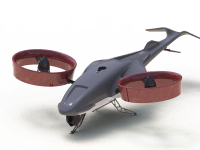
Over 1,000,000 people are killed each year during urban disasters. 2,500,000 people will be permanently disabled or displaced, and the affected communities will take 20 to 30 years to recover and billions of dollars in economic losses. If we can reduce the initial response by one day we can reduce the overall recovery by 3 years. If the initial responders can get in, assess the situation, save lives, and mitigate whatever flooding danger there is, that means the other groups such as restoration, reconstruction, and betterment can get in to restore the water, the roads, and the services faster.
Urban Search and Rescue (USAR) robots and drones can save lives and limit the monetary consequences of disasters. However, the biggest two limitations to the widespread deployment of USAR robots and the realization of their full potential is their limited agility to move inside confined spaces.
USAR involves the location, extrication, and initial medical stabilization of victims trapped in accidental and deliberate structural collapse found inside collapsed and burning buildings, city streets, collapsed trenches, and mines as well as remote difficult-to-reach locations. USAR is considered a multi-hazard discipline, as it may be needed for a variety of hazards including earthquakes, tornadoes, floods, technological accidents, terrorist activities, and hazardous materials releases. In a disaster situation, the goal of SAR is to rescue the greatest number of people in the shortest amount of time, while minimizing the risk to rescuers.
USAR teams must be self-sufficient for the first 72 hours of deployment. Thus, they must carry with them all the required equipment to perform the following five tasks:
- Evaluate and stabilize damaged structures (e.g., collapsed buildings and affected roads), and infrastructure (e.g., vehicles, trains, and oil refineries),
- Conduct physical search-and-rescue inside collapsed structures,
- Find survivors,
- Provide medical care to people who are in distress or victims trapped and/or immobilized, and
- Assess and control utilities and hazardous materials.
To meet these needs, we have developed an advanced scalable aircraft, called the Navig8, capable of performing three of the five tasks mentioned above (i.e., Tasks No. 1, 2, and 3). The Navig8 is a highly maneuverable tiltrotor vertical takeoff and landing (VTOL) aircraft capable of flight in helicopter impenetrable environments such as inside collapsed buildings, beneath tree cover, and other complex hazardous environments.
Along with other improvements, the discovery of a system capable of performing advanced flight without the need for typical control surfaces such as ailerons and rudders has enabled an aircraft that has been highly attractive, yet unattainable in the past. The unique flying characteristics of the Navig8 aircraft enables it to:
- Perform pitch hover maneuvers, an advanced characteristic allowing advanced flight features not seen in helicopters, such as the ability to pitch while remaining in a stationary hover (e.g., land and take off from highly slopped mountainous terrains).
- Lift heavier payloads by 50% to 60% when compared to similar size aircraft.
- Perform acrobatic maneuvers at zero speed and thus, fly inside geometrically complex environments.
Video
-
Awards
-
 2024 Top 100 Entries
2024 Top 100 Entries
Like this entry?
-
About the Entrant
- Name:Alex Ramirez Serrano
- Type of entry:individual
- Patent status:none








